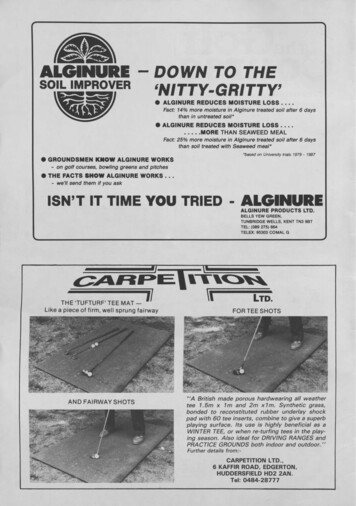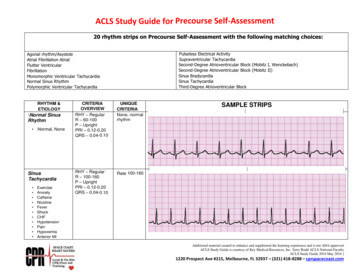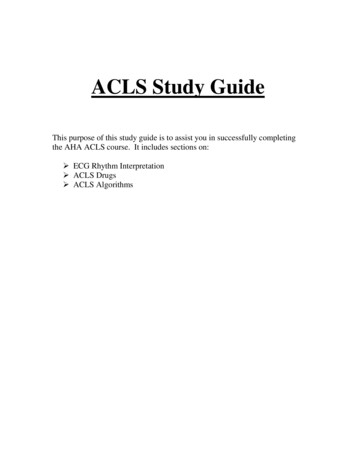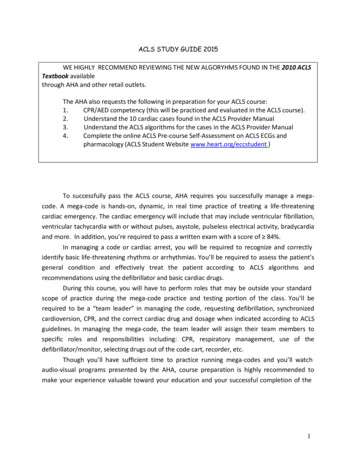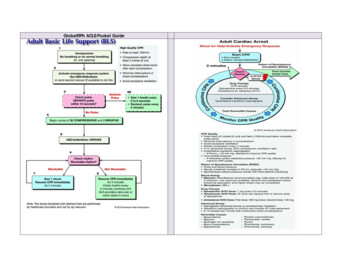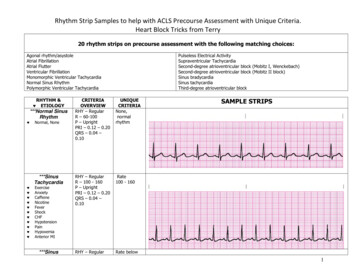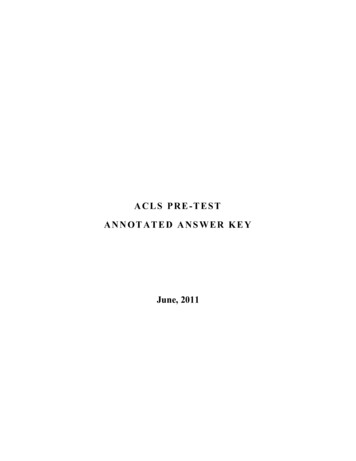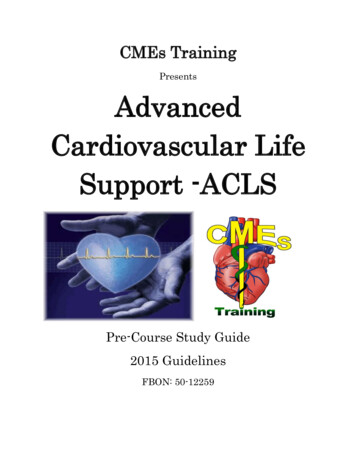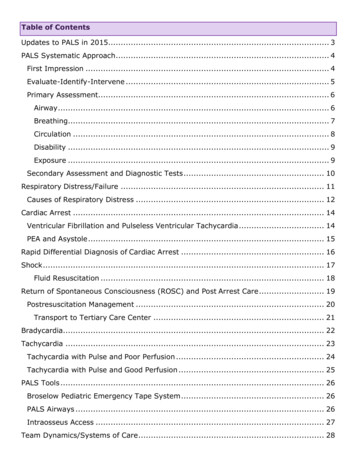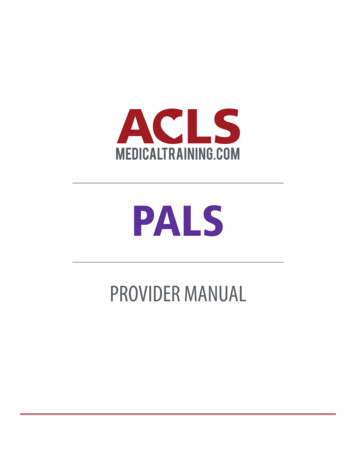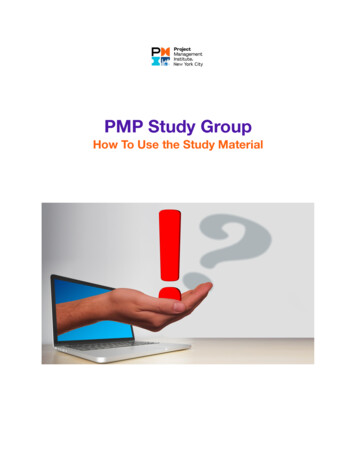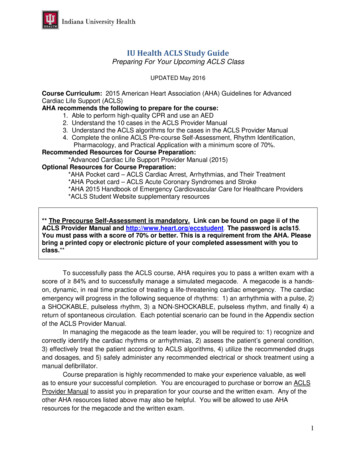
Transcription
IU Health ACLS Study GuidePreparing For Your Upcoming ACLS ClassUPDATED May 2016Course Curriculum: 2015 American Heart Association (AHA) Guidelines for AdvancedCardiac Life Support (ACLS)AHA recommends the following to prepare for the course:1. Able to perform high-quality CPR and use an AED2. Understand the 10 cases in the ACLS Provider Manual3. Understand the ACLS algorithms for the cases in the ACLS Provider Manual4. Complete the online ACLS Pre-course Self-Assessment, Rhythm Identification,Pharmacology, and Practical Application with a minimum score of 70%.Recommended Resources for Course Preparation:*Advanced Cardiac Life Support Provider Manual (2015)Optional Resources for Course Preparation:*AHA Pocket card – ACLS Cardiac Arrest, Arrhythmias, and Their Treatment*AHA Pocket card – ACLS Acute Coronary Syndromes and Stroke*AHA 2015 Handbook of Emergency Cardiovascular Care for Healthcare Providers*ACLS Student Website supplementary resources** The Precourse Self-Assessment is mandatory. Link can be found on page ii of theACLS Provider Manual and http://www.heart.org/eccstudent. The password is acls15.You must pass with a score of 70% or better. This is a requirement from the AHA. Pleasebring a printed copy or electronic picture of your completed assessment with you toclass.**To successfully pass the ACLS course, AHA requires you to pass a written exam with ascore of 84% and to successfully manage a simulated megacode. A megacode is a handson, dynamic, in real time practice of treating a life-threatening cardiac emergency. The cardiacemergency will progress in the following sequence of rhythms: 1) an arrhythmia with a pulse, 2)a SHOCKABLE, pulseless rhythm, 3) a NON-SHOCKABLE, pulseless rhythm, and finally 4) areturn of spontaneous circulation. Each potential scenario can be found in the Appendix sectionof the ACLS Provider Manual.In managing the megacode as the team leader, you will be required to: 1) recognize andcorrectly identify the cardiac rhythms or arrhythmias, 2) assess the patient’s general condition,3) effectively treat the patient according to ACLS algorithms, 4) utilize the recommended drugsand dosages, and 5) safely administer any recommended electrical or shock treatment using amanual defibrillator.Course preparation is highly recommended to make your experience valuable, as wellas to ensure your successful completion. You are encouraged to purchase or borrow an ACLSProvider Manual to assist you in preparation for your course and the written exam. Any of theother AHA resources listed above may also be helpful. You will be allowed to use AHAresources for the megacode and the written exam.1
This study guide is not to be considered a replacement for the ACLS Provider Manual, theonline pre-course assessment, and other resources offered by the AHA.BLS CPRThe sequence for CPR is “CAB”: Compressions – Airway – Breathing. Here are the basicsteps in the BLS assessment:1. Scene Safety2. Check for responsiveness3. Call for help and an AED (in hospital, call Medical Alert-Code Blue)4. Simultaneously scan the chest for breathing and pulse5. If no pulse, begin compressions – give 30 compressions then give twobreaths—continue 30:2 ratio; maintain a rate of 100-120 compression/minat a depth of 2-2.4 inches6. Apply the AED as soon as it arrivesBradycardia - Any rhythm disorder with a rate 50/min in a symptomatic patient.Theclinical picture is important here to determine if the patient needs monitoring or treatment. Thegoal in the management of symptomatic bradycardia is clinical improvement.SINUS BRADYCARDIA1ST DEGREE HEART BLOCK2ND DEGREE HEART BLOCK (Mobitz Type I Wenkebach)2nd DEGREE HEART BLOCK (MOBITZ Type II)3RD HEART BLOCK2
Identify and treat underlying causes: open airway, assist breathing, O2 administration, applymonitors, 12 lead ECG, establish IV/IO access, obtain labs, and seek expert consultation.Is your patient with Bradycardia stable or unstable?STABLE / Symptomatic – Administer Atropine 0.5mg Monitor and observeUNSTABLE / Symptomatic – showing signs of poor perfusion (heart rate is not fast enough todeliver an adequate volume of blood to the body and requires treatment/intervention), forexample: ischemic chest pain, hypotensive, feels faint/light-headed, decreased or alteredmental status, cool or clammy/diaphoretic. Administer Atropine 0.5mg Prepare and provide external transcutaneous pacingOR Administer Dopamine infusion 2-20 mcg/kg/minuteOR Administer Epinephrine infusion: 2-10 mcg per minuteAND Consider expert consultationSupraventricular Tachycardia (SVT) - SUSTAINED - Rapid, narrow QRS, rhythmtachycardia with a rate 150Identify and treat underlying causes: open airway, assist breathing, O2 administration, applymonitors, 12 lead ECG, establish IV/IO access, obtain labs, and seek expert consultation.Is your patient stable or unstable?STABLE Attempt vagal maneuvers: bear down, hard cough, etc. If vagal maneuvers aren’t successful: administer Adenosine 6 mg, if rhythm isregular You may repeat with Adenosine 12 mg If both doses of Adenosine are unsuccessful: seek expert consultationUNSTABLE – showing signs of poor perfusion (low B/P, feels faint, decreased or altered mentalstatus, cool or clammy/diaphoretic, chest discomfort) and requires rapidtreatment/intervention. Provide Synchronized Cardioversion 50 – 100 Joules Provide Synchronized Cardioversion of 120-200 Joules when treating irregular and rapidheart rate3
Monomorphic Ventricular Tachycardia with a pulse (VT/V-Tach)SUSTAINED - rapid, regular uniform, wide complex (monomorphic) tachycardia lasting 30secondsIdentify and treat underlying causes: open airway, assist breathing, O2 administration, applymonitors, 12 lead ECG, establish IV/IO access, obtain labs, and seek expert consultation.Is your patient stable or unstable?STABLE Seek expert consultation Consider antiarrhythmic infusion – Amiodarone 150 mg over 10 minutes (Procainamide,Sotalol are other antiarrhythmic options)UNSTABLE – showing signs of poor perfusion or shock (hypotension, ischemic chest pain,weak,clammy, cold, ashen, faint, acute mental status changes) Deliver immediate synchronized cardioversion at 100 Joules Evaluate the rhythm post cardioversion. If continued VT with a pulse, consider asecond attempt at a higher energy levelVentricular Fibrillation (V-Fib/VF)Pulseless Ventricular Tachycardia (VT/V-Tach)4
Both V-Fib and Pulseless V-Tach require immediate defibrillation. Once you determine yourpatient has one of these arrhythmias (completed your BLS survey and identified the rhythm),proceed as follows: Initiate Code Blue and begin chest compressions Defibrillate asap Immediately resume CPR for 2 minutes During this 2 minute cycle:o Obtain IV or IO accesso Prepare your first drug: Epinephrine 1 mgo Begin discussing reversible causes After 2 minutes, perform a rhythm check – if unchanged:o Defibrillate asap (2nd shock)o Resume CPRo Administer Epinephrine 1 mgo Prepare second drug: Amiodarone 300 mg Continue to work in 2 minute cycles. After each subsequent defibrillation:o If appropriate, administer the drug you have preparedo Prepare your next drugo Continue to talk about reversible causes (Hs and Ts)Asystole – There is no electrical or mechanical activity. Asystole is a pulseless, nonshockable rhythm that requires immediate intervention.Pulseless Electrical Activity (PEA) – Electrical activity without mechanicalcontractility. There is an organized rhythm, but the heart is not pumping . PEA is a pulseless,non-shockable rhythm that requires immediate intervention.NO PULSEOnce you determine your patient has one of the above rhythms (completed your BLS surveyand identified the rhythm), proceed as follows: Initiate Code Blue and begin chest compressions Administer Epinephrine 1 mg Work in 2 minute CPR cycles Epinephrine 1 mg given every other cycle or every 3-5 minutes5
Reversible Causes / Hs and TsA critical step to restoring a perfusing rhythm is to quickly identify the underlying, reversiblecauses. The most common are known as the Hs & Ts.HsTs Hypovolemia Tension Pneumothorax Hypoxia Tamponade, cardiac Hydrogen Ion (Acidosis) Thrombosis, pulmonary (PE) Hypo-/Hyperkalemia Thrombosis, cardiac Hypothermia Toxins (Drugs/Environmental)ROSC (Return of Spontaneous Circulation) a.k.a. Post-Cardiac Arrest CareThe following are the post arrest needs that should be addressed when ROSC occurs: FIRST, check Airway and Breathing (C-A-B)Is the patient breathing?o If not, intubate and begin capnography monitoring What is the blood pressure?o If less than 90 systolic, give a fluid bolus 1-2 L of Normal Saline or LactatedRingers and/or consider a pressor, epi, dopamine Is the patient responding?o If not, initiate the targeted temperature management: 32-36C for at least 24hours 12 Lead ECG Labs Chest X-Ray Cardiology ConsultDuring class you will have opportunity to get hands-on practice with each of the above rhythmsand ACLS algorithms that you have just studied. If you study the content, the application in thesimulation labs will pull it all together for you, and your instructors will answer any additionalquestions you may have.This content is not intended to replace your ACLS ProviderManual. You are highly encouraged to utilize the manual inpreparation for and while attending class.6
ACLS PharmacologyDrugs for BradycardiaAtropine: 0.5mg IV/IO IV Push followed by a flush; repeat every 3-5 minutes. Max total dose:3 mg (6 doses)-First-line drug for symptomatic bradycardiaDopamine drip: 2-20 mcg/kg/min as an IV Infusion-Titrate to patient response-Second-line drug for symptomatic bradycardiaEpinephrine drip: 2-10 mcg/min as an IV Infusion-Titrate to patient response-Second-line drug for symptomatic bradycardiaDrugs for SVTAdenosine: 6 mg rapid IV Push followed by an immediate 20 ml flush; may repeat with a 12mg dose if needed.-Fast push and fast acting drug that results in a short period of asystoleDrugs for Stable Wide Complex VTAntiarrhythmic Options:Amiodarone: 150 mg IV over 10 min. May repeat every 10 min. prnProcainamide: 20-50 mg/min. IV until symptoms subside or max dose: 17 mg/kgSotalol: 100 mg (1.5 mg/kg) IV over 5 min.Lidocaine: 0.5-0.75 mg/kg and up to 1-1.5 mg/kg IV. May repeat every 5-10 min. Max totaldose: 3 mg/kgDrugs for Pulseless Arrest - VF/VTEpinephrine (1:10,000 concentration): 1 mg IV/IO Push followed by a flush; repeatthroughout code every 3-5 minutes. There is no max total dose.Amiodarone: 300 mg IV/IO Push followed by a flush. Second dose (if needed) 150 mg. Maxtotal dose: 450 mg(Lidocaine is an alternative to Amiodarone, though Amio is recommended. The dose ofLidocaine is 1-1.5 mg/kg)Magnesium Sulfate is recommended for use in cardiac arrest only if torsades de pointes orsuspected hypomagnesemia is present. The dose of Mag Sulfate is 1-2 grams diluted andadministered over 5 to 60 minutes.Drugs for Pulseless Arrest - Asystole/PEAEpinephrine (1:10,000 concentration): 1mg IV/IO Push followed by a flush; repeatthroughout code every 3-5 minutes. There is no max total dose.7
Drugs for ACS (Acute Coronary Syndromes): MONAM MorphineO Oxygen (for oxygen saturation less than 90%)N NitratesA AspirinMorphine: Initial dose is 2 to 4 mg IV over 1 to 5 min. May repeat 2-8 mg every 5-15 min.-May administer to patients with suspected ischemic pain unresponsive to nitrates-Contraindications: Hypotension-Re-evaluate patient between dosesNitroglycerin: 1 tablet (0.3-0.4 mg) sublingually; may be repeated every 5 min. up to a totalof 3 doses OR 1-2 sprays (over 0.5-1 second) sublingually – max 3 sprayswithin 15 minutes-First-line drug for suspected ischemic chest pain in ACS-Vasodilator - improves blood flow and reduces ischemic chest discomfort-Contraindications: Hypotension Bradycardia Tachycardia RV Infarction Use of phosphodiesterase inhibitors in past 24-48 hrsAspirin: 160 mg to 325 mg given/chewed; non-coated baby or adult aspirin-Indications — Standard therapy for all patients with symptoms suggestive of ACS-May use rectal suppository for patients who cannot take orally-Inhibits platelet aggregation (stops clot formation)-Contraindications: Allergy to aspirin Active GI BleedReferencesAdvanced Cardiac Life Support Provider Manual, (2016). Dallas, Texas: American HeartAssociation.2015 Handbook of Emergency Cardiovascular Care for Healthcare Providers, (2015), AmericanHeart Association.ACLS Acute Coronary Syndromes and Stroke Pocket Card, (2016), American Heart Association.ACLS Cardiac Arrest, Arrhythmias, and Their Treatment Pocket Card, (2016), American HeartAssociation.8
IU Health ACLS Study Guide Preparing For Your Upcoming ACLS Class. UPDATED May 2016 . Course Curriculum: 2015 American Heart Association (AHA) Guidelines for Advanced Cardiac Life Support (ACLS) AHA recommends the following to prepare for the course: 1. Able to perform high-quality CPR and use an AED . 2. Understand the 10 cases in the ACLS Provider Manual . 3. Understand the ACLS
